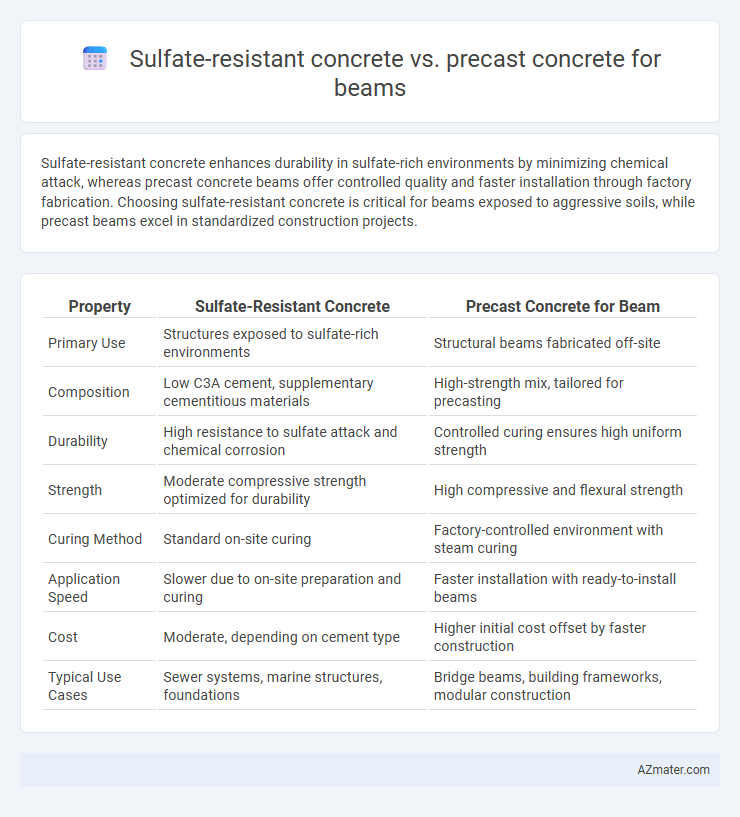Sulfate-resistant concrete enhances durability in sulfate-rich environments by minimizing chemical attack, whereas precast concrete beams offer controlled quality and faster installation through factory fabrication. Choosing sulfate-resistant concrete is critical for beams exposed to aggressive soils, while precast beams excel in standardized construction projects.
Table of Comparison
| Property | Sulfate-Resistant Concrete | Precast Concrete for Beam |
|---|---|---|
| Primary Use | Structures exposed to sulfate-rich environments | Structural beams fabricated off-site |
| Composition | Low C3A cement, supplementary cementitious materials | High-strength mix, tailored for precasting |
| Durability | High resistance to sulfate attack and chemical corrosion | Controlled curing ensures high uniform strength |
| Strength | Moderate compressive strength optimized for durability | High compressive and flexural strength |
| Curing Method | Standard on-site curing | Factory-controlled environment with steam curing |
| Application Speed | Slower due to on-site preparation and curing | Faster installation with ready-to-install beams |
| Cost | Moderate, depending on cement type | Higher initial cost offset by faster construction |
| Typical Use Cases | Sewer systems, marine structures, foundations | Bridge beams, building frameworks, modular construction |
Introduction to Sulfate-Resistant and Precast Concrete Beams
Sulfate-resistant concrete beams are specifically engineered to withstand the chemical attack of sulfates commonly found in soil and groundwater, using low C3A cement and supplementary cementitious materials like fly ash or slag to enhance durability. Precast concrete beams are manufactured in controlled factory environments, ensuring high quality, dimensional accuracy, and faster installation on site due to their prefabricated nature. The choice between sulfate-resistant and precast concrete beams depends on environmental exposure, project timeline, and structural requirements, with sulfate-resistant beams offering superior protection in sulfate-rich conditions and precast beams providing efficiency and consistency in production.
Key Properties of Sulfate-Resistant Concrete
Sulfate-resistant concrete is specially formulated with low C3A cement content and supplementary cementitious materials like fly ash or slag to enhance its durability against sulfate attack, making it ideal for beams exposed to aggressive sulfate environments. It exhibits superior chemical resistance, reduced permeability, and improved long-term strength compared to standard precast concrete, which may not withstand sulfate-induced deterioration. Key properties include a low water-to-cement ratio, high compressive strength, and enhanced resistance to sulfate ions, ensuring structural integrity and longevity in sulfate-rich soils or waters.
Overview of Precast Concrete Techniques for Beams
Precast concrete techniques for beams involve casting concrete in a controlled factory environment, ensuring high-quality finishes and precise dimensions. These beams are then transported to the construction site for rapid installation, reducing on-site labor and curing time compared to traditional sulfate-resistant concrete poured in place. This method enhances structural integrity and durability, especially in projects requiring consistent quality and swift assembly.
Durability and Longevity: Sulfate-Resistant vs Precast Concrete
Sulfate-resistant concrete offers enhanced durability in environments with high sulfate concentrations by minimizing chemical attacks that cause concrete degradation. Precast concrete beams provide controlled quality and high strength but may require additional sulfate-resistant admixtures or coatings to withstand aggressive sulfate conditions. Selecting sulfate-resistant concrete ensures extended longevity and structural integrity in sulfate-rich soils compared to standard precast concrete.
Resistance to Environmental Factors and Chemical Attack
Sulfate-resistant concrete offers enhanced durability against chemical attacks, especially in environments with high sulfate concentrations, by using low C3A cement content to minimize sulfate-induced expansion and cracking. Precast concrete beams provide controlled manufacturing conditions that improve consistency and quality, but their resistance to environmental factors largely depends on the concrete mix design and curing process, which may or may not include sulfate resistance. For structures exposed to aggressive sulfate-rich environments, sulfate-resistant concrete is preferred due to its proven effectiveness in mitigating chemical degradation compared to standard precast concrete.
Installation Process and Construction Speed Comparison
Sulfate-resistant concrete requires careful mixing with specific sulfate-resisting cement and additives to ensure durability in aggressive environments, often extending the curing time to 28 days for optimal strength. Precast concrete beams are manufactured off-site under controlled conditions, allowing simultaneous production and site preparation, significantly accelerating installation and reducing on-site construction time. The installation process for precast beams is faster due to minimal curing required, enabling quicker structural assembly compared to the lengthier curing and placement process of sulfate-resistant cast-in-place beams.
Cost Analysis: Material and Labor Considerations
Sulfate-resistant concrete typically incurs higher material costs due to specialized cement and additives designed to withstand sulfate attack, impacting the overall budget for beam construction. Precast concrete benefits from controlled factory conditions that reduce labor costs and construction time on-site, offering a cost advantage despite transportation expenses. When analyzing cost efficiency for beams, sulfate-resistant concrete demands careful material budgeting, whereas precast concrete optimizes labor savings and consistency in quality.
Structural Performance and Load-Bearing Capacity
Sulfate-resistant concrete enhances durability in aggressive sulfate environments, reducing chemical attacks and maintaining structural integrity over time, which significantly boosts the beam's load-bearing capacity. Precast concrete beams offer precise manufacturing control, uniform quality, and high initial strength, resulting in consistent structural performance and efficient load transfer. When comparing both, sulfate-resistant concrete excels in longevity under harsh conditions, while precast concrete optimizes production efficiency and dimensional accuracy for reliable load-bearing applications.
Maintenance and Lifecycle Management
Sulfate-resistant concrete beams exhibit superior durability in aggressive sulfate environments, minimizing maintenance requirements by preventing sulfate attacks that cause cracking and spalling. Precast concrete beams offer controlled manufacturing quality and accelerate construction timelines, but their maintenance demands depend on site conditions and joint integrity over the lifecycle. Effective lifecycle management for sulfate-resistant concrete emphasizes long-term performance in harsh soils, while precast beams require regular inspection of connections to ensure structural reliability.
Best Applications: Choosing the Right Concrete for Beam Projects
Sulfate-resistant concrete is ideal for beam projects exposed to aggressive sulfate soils or groundwater, ensuring durability and preventing chemical deterioration. Precast concrete beams excel in controlled factory environments, promoting consistent quality, faster installation, and reduced on-site labor costs. Selecting between sulfate-resistant and precast concrete depends on environmental exposure and project timeline priorities to optimize beam performance and longevity.

Infographic: Sulfate-resistant concrete vs Precast concrete for Beam
 azmater.com
azmater.com